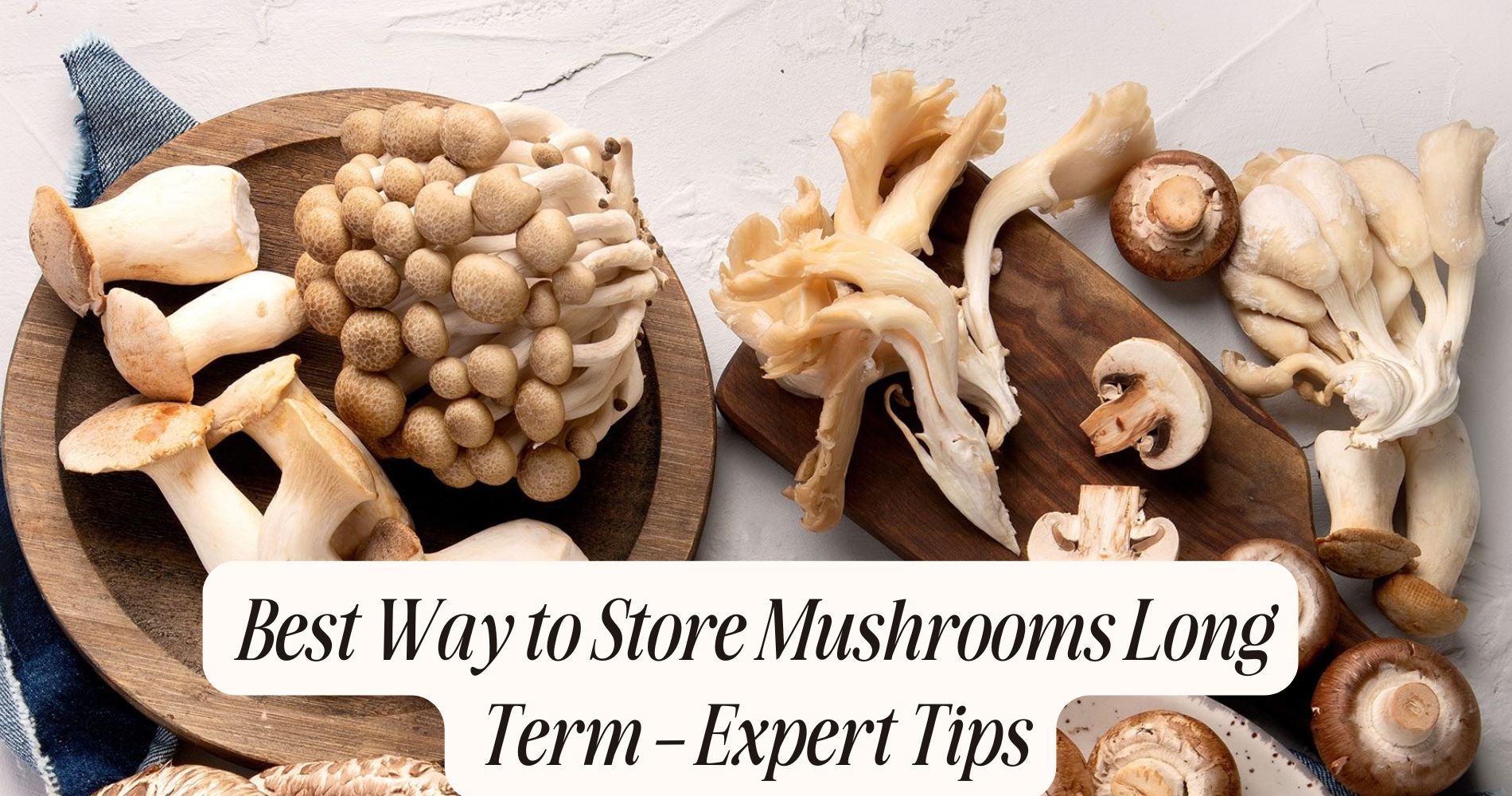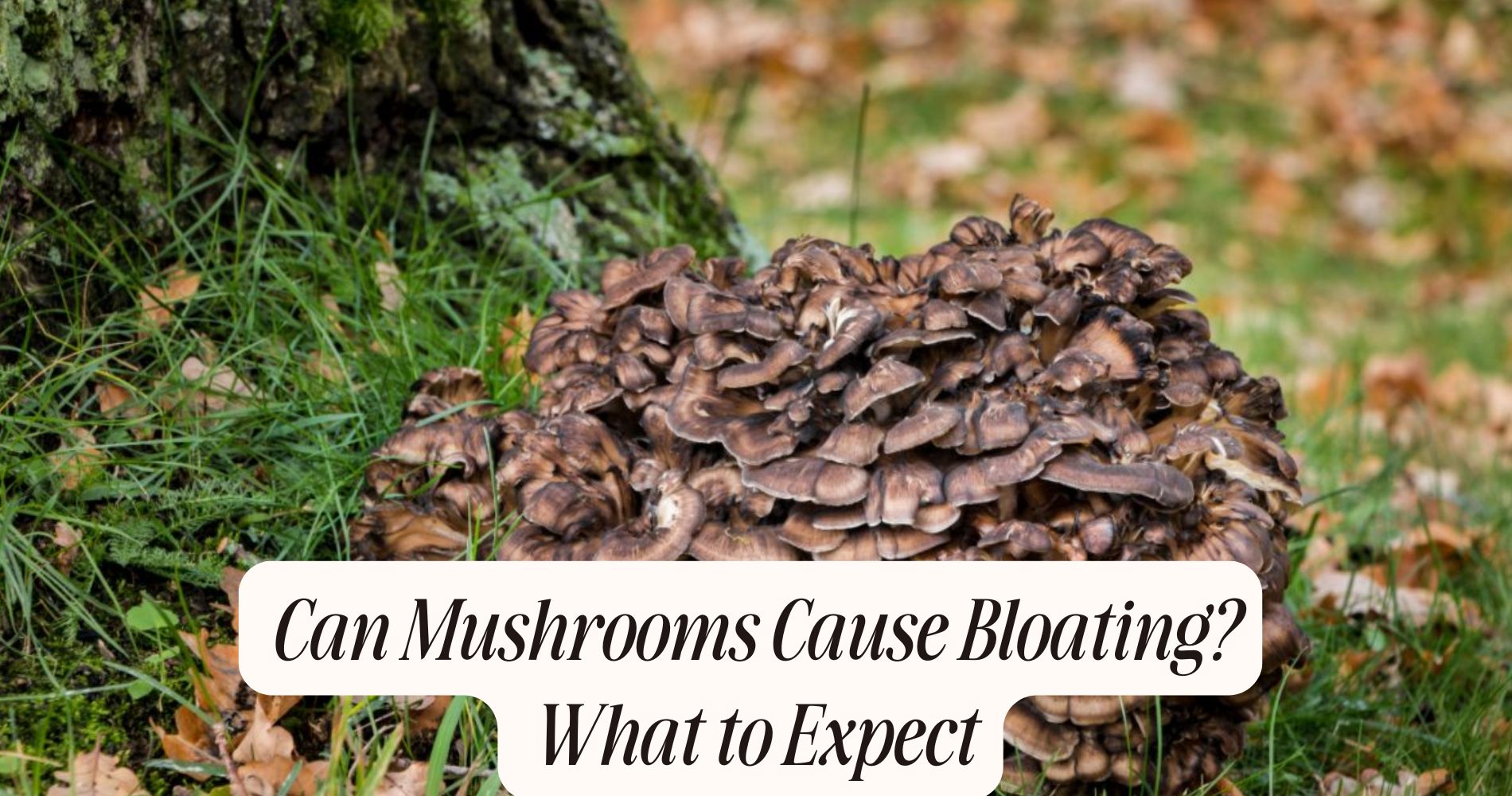
Best Way to Store Mushrooms Long Term – Expert Tips
Finding the best way to store mushrooms long term ensures you preserve their flavor, texture, and nutrients without waste. Start by choosing firm, undamaged varieties like button or shiitake. Dehydrating at 45–50°C, blanching before freezing, or vacuum sealing are all effective strategies for long-lasting freshness. You can also pressure can or pickle mushrooms for extended shelf stability. Understanding proper techniques and knowing how to spot spoilage are key steps to safe, long-term storage success. Let’s dive into the top methods that work.
Understanding Mushroom Shelf Life
Although mushrooms are prized for their delicate flavors and nutritional value, their shelf life is inherently short due to their high water content and porous cellular structure. When you store mushrooms, you need to understand how rapidly they deteriorate; enzymatic browning, microbial growth, and moisture loss all contribute to spoilage.

Mushroom nutrient content—particularly B vitamins, potassium, and antioxidants—declines as decomposition progresses, so maintaining freshness is critical for ideal health benefits.
Proper mushroom harvesting techniques also directly influence shelf life. If you harvest mushrooms at peak maturity, using sanitized tools and gentle handling, you’ll minimize bruising and microbial contamination.
Immediate post-harvest cooling further extends viability by slowing metabolic activity.
Choosing the Right Mushrooms for Storage
When selecting mushrooms for long-term storage, prioritize varieties with firm texture, minimal surface damage, and low moisture content, as these characteristics directly influence preservation outcomes. Choose button, cremini, shiitake, or porcini mushrooms, since their dense structure resists spoilage.

Avoid delicate or water-rich types, like enoki or oyster, as they deteriorate rapidly and complicate storage. Inspect each specimen closely; look for intact caps, unblemished stems, and absence of sliminess, which signals microbial activity.
Matching mushroom varieties to your intended culinary uses is critical—shiitake and porcini retain robust flavor after drying, while button and cremini adapt well to multiple preservation techniques.
Preparing Mushrooms for Long-Term Storage
Before you preserve mushrooms for long-term storage, meticulous preparation is essential to prevent spoilage and maintain quality. Start by employing proper mushroom cleaning techniques: instead of soaking, gently brush off dirt with a soft brush or wipe each mushroom with a damp cloth to avoid excess moisture, which can accelerate decay.
Trim the stems and remove any damaged or discolored areas using a sanitized knife. For peak results, ensure mushrooms are dry before proceeding.
Next, select suitable packaging materials for mushrooms based on your chosen storage method. Use vacuum-sealable bags for freezing or dehydration to limit oxygen exposure and inhibit microbial growth. Food-grade glass jars with airtight lids are ideal for dried mushrooms.
Always label your containers with the date and mushroom variety to maintain traceability and freshness.
Refrigerating Fresh Mushrooms Properly
To maximize the shelf life of fresh mushrooms in the refrigerator, control both humidity and airflow within their storage environment. Freshly harvested mushrooms, whether from commercial mushroom cultivation or home mushroom harvesting, are highly perishable due to their high water content and delicate cellular structure.
Avoid storing mushrooms in airtight containers, as this traps moisture and promotes microbial spoilage. Instead, use a paper bag or a container lined with paper towels, which absorbs excess humidity while allowing for necessary air exchange.

Store the container on a refrigerator shelf, maintaining a temperature between 1°C and 4°C (34°F–39°F) to slow enzymatic degradation and bacterial growth.
Avoid washing mushrooms before storage, as surface moisture accelerates decay. Following these steps preserves texture, flavor, and nutritional value.
Freezing Mushrooms for Maximum Freshness
Although fresh mushrooms have a short shelf life, freezing extends their usability by halting enzymatic and microbial activity responsible for spoilage.
To maximize preservation, you should first clean and slice the mushrooms, then blanch them in boiling water or steam for 1–3 minutes. This step deactivates enzymes, preserving both texture and mushroom nutrition.
Promptly cool the mushrooms in ice water to stop the cooking process, then drain and pat them dry.
Place them in airtight, freezer-safe containers to prevent freezer burn and nutrient loss.
By integrating these scientific techniques, you maintain the integrity of mushrooms, regardless of their origin from home mushroom cultivation or commercial sources.
Proper freezing ensures that protein, B-vitamins, and antioxidants remain bioavailable, supporting ideal mushroom nutrition during long-term storage.
Drying Mushrooms for Extended Use
While freezing mushrooms preserves their nutritional profile, drying offers another scientifically robust method for long-term storage by removing moisture that microorganisms need to thrive.
You’ll want to select fresh, clean mushrooms, slicing them evenly to ensure uniform dehydration. Among mushroom drying methods, air drying is traditional but less reliable due to inconsistent airflow and humidity. Instead, apply dehydrator techniques for ideal results.
Set your food dehydrator to 45–50°C (113–122°F) and arrange mushroom slices in a single layer. This controlled environment accelerates moisture removal, minimizes enzymatic degradation, and prevents spoilage.
Once thoroughly dried—brittle texture is ideal—store mushrooms in airtight containers away from light and moisture. Proper drying and storage will preserve flavor, texture, and nutritional value for months or even years.
Pickling and Canning Mushrooms
Because mushrooms have a high water content and low acidity, pickling and canning require precise techniques to guarantee safety and shelf stability. You’ll need to use a pressure canner, not a water bath, since mushrooms are a low-acid food and susceptible to botulism.
Before canning, clean and blanch your mushrooms to maintain ideal mushroom nutrition and texture. Use tested recipes that specify vinegar concentration and processing times.
Pickling introduces an acidic environment, inhibiting microbial growth while preserving flavor.

If you engage in mushroom cultivation, select firm, fresh specimens for best results.
Always sterilize jars and lids, and avoid altering ingredient ratios. Following these scientific guidelines ensures that you can safely store mushrooms long-term without compromising the nutritional benefits inherent to a successful harvest.
Using Vacuum Sealing to Prevent Spoilage
Since mushrooms are highly perishable due to their high moisture content and porous structure, vacuum sealing offers a reliable method to extend their shelf life by minimizing oxygen exposure.
By using vacuum sealer techniques, you remove atmospheric air, which substantially reduces the risk of microbial growth and enzymatic browning—two primary causes of spoilage.
Select fresh, dry mushrooms and place them in specialized vacuum bags. Use a vacuum sealer to extract the air, creating an airtight environment that inhibits mold and bacterial proliferation.
The airtight storage benefits include preservation of texture, flavor, and nutritional integrity for several weeks when refrigerated or even longer when frozen.
Always ensure proper sealing to prevent air infiltration, as even minor leaks can compromise the protective environment and reduce storage efficacy.
Storing Cooked Mushrooms Safely
After you cook mushrooms, rapid cooling and proper storage become essential to prevent bacterial growth and texture degradation. Immediately transfer cooked mushrooms from the heat source to a shallow container, allowing for efficient heat dissipation.
Refrigerate within two hours at or below 40°F (4°C). This ensures preservation of both safety and the nuanced mushroom flavor profiles characteristic of various culinary mushroom varieties, such as shiitake, cremini, or oyster.
Avoid stacking mushrooms too densely, as this can trap residual heat and moisture, accelerating spoilage.

For extended storage, freeze cooked mushrooms in airtight containers; this halts enzymatic activity and locks in both texture and aroma.
When reheating, use only the portion needed to prevent repeated temperature fluctuations, which can compromise both safety and the integrity of their unique flavors.
Recognizing Signs of Spoiled Mushrooms
Although mushrooms can maintain quality for several days when stored properly, they’re highly perishable and provide clear indicators when spoilage occurs.
You should inspect them for visual and textural changes. The most prominent sign is mushroom mold, which can appear as fuzzy, green, blue, or white patches on the surface. Mold growth indicates fungal contamination and renders mushrooms unsafe for consumption.
Additionally, a slimy texture suggests bacterial activity and advanced decomposition. Fresh mushrooms should feel dry and firm; any dampness or stickiness signals spoilage.
Off-putting odors, such as sour or ammonia-like smells, also signify microbial breakdown. If you notice wrinkling or dark spots, the mushrooms are deteriorating but not necessarily spoiled.
Always discard mushrooms exhibiting mold or a slimy texture to prevent foodborne illness.
Your Long-Term Mushroom Solution, Made Simple
While storing mushrooms long term helps preserve their nutrients, there's an easier way to enjoy daily mushroom benefits—SUPER MUSHROOM GUMMIES by Well Gummies. Packed with 10 functional mushrooms in a tasty wild berry chew, these vegan gummies are your go-to for sharper focus, immune support, and sustained energy—without the hassle of cooking or storing. No jitters, no crash—just clean, convenient wellness you’ll actually look forward to.
Frequently Asked Questions
Can I Store Mushrooms With Other Vegetables or Fruits?
You shouldn't store mushrooms with other vegetables or fruits because ethylene gas accelerates spoilage. For ideal preservation, use mushroom drying to remove moisture, then vacuum sealing to prevent microbial growth and oxidative reactions, ensuring maximum longevity and quality retention.
Are Wild Mushrooms Safe to Store Long Term?
You shouldn't store wild mushrooms long term unless you're absolutely certain about mushroom identification, as wild mushroom toxicity can persist or even increase in storage. Misidentification risks severe poisoning, so consult a mycologist before considering preservation methods.
Do Storage Methods Differ for Medicinal Versus Culinary Mushrooms?
You’ll find storage methods differ because medicinal mushrooms often require specific dehydration techniques to preserve bioactive compounds, while culinary types can tolerate standard dehydration or freezing methods without losing flavor or texture. Always tailor your approach for ideal preservation.
How Does Humidity Affect Long-Term Mushroom Storage?
When you store mushrooms long-term, you must maintain precise humidity control. Excess moisture encourages mold growth, while low humidity causes desiccation. By optimizing humidity, you enhance mold prevention and preserve mushrooms’ cellular integrity, nutritional value, and bioactive compounds.
What Are the Best Containers for Mushroom Storage?
When selecting mushroom container varieties, you’ll want to use the most suitable storage containers—breathable materials like paper bags or perforated plastic boxes. These regulate humidity, limit condensation, and minimize microbial growth, ensuring mushrooms maintain ideal texture and nutritional value.
Conclusion
By applying scientific storage methods, you’ll preserve your mushrooms’ quality and nutrition. Choose the right varieties, prep them carefully, and use refrigeration, freezing, pickling, or vacuum sealing to slow enzymatic and microbial spoilage. Always monitor for signs of degradation like off-odors, discoloration, or slime. Proper technique not only extends shelf life but also retains texture and flavor. With these expert-backed strategies, you can confidently enjoy mushrooms long after harvest without compromising safety or quality.




